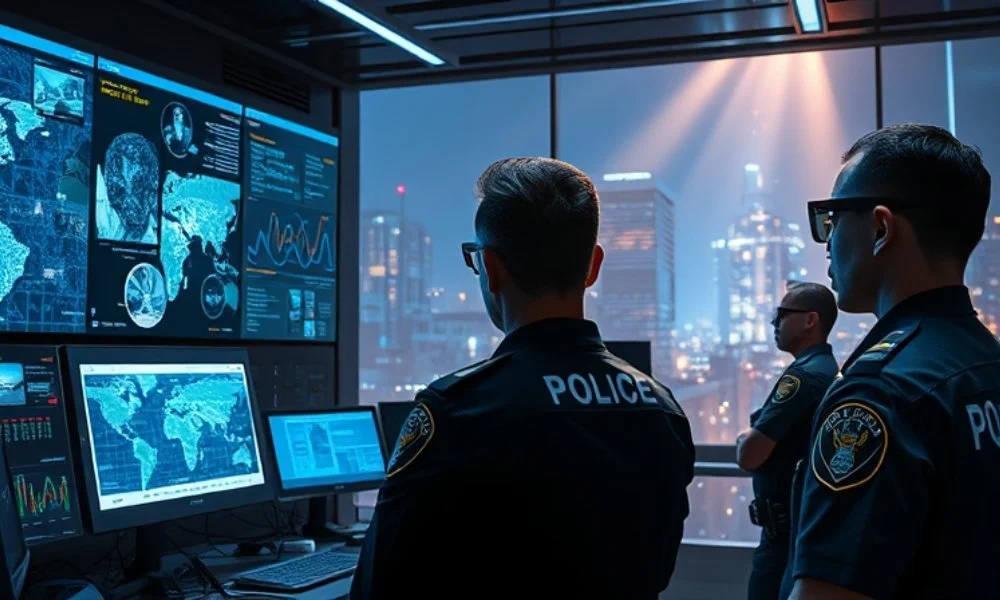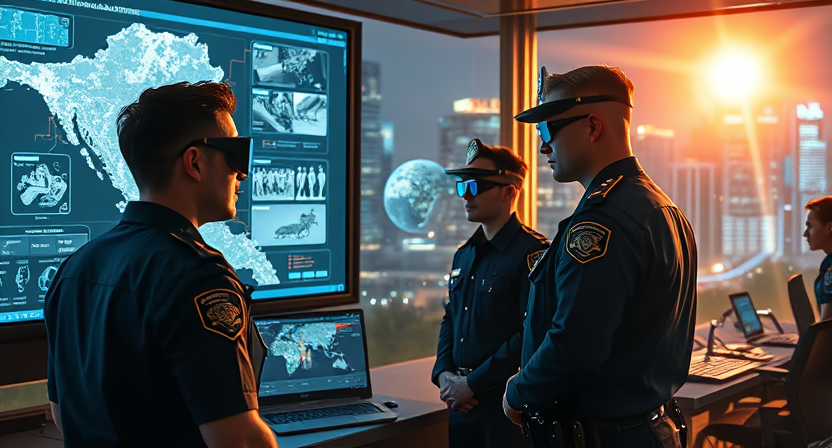Artificial Intelligence
AI Policing and Data Fusion in Law Enforcement

Crime is increasing, and the investigation processes are much more challenging, and the older techniques are no longer very effective. Well, did you know that police departments all over the world are using new artificial intelligence and data integration to transform their work? This blog will discuss how advanced technology such as artificial intelligence and data fusion impact policing.
Definition:
In this article, we’ll see the problems today’s policing, advantages of such technologies, and how with solutions like C3 AI, investigations are revolutionized.
Why Are Rising Crime Rates Straining Agencies?
All sorts of crimes have been on the rise in the United States ranging from cybercrime to physical violence. This is extremely challenging with limited workforce and especially if one has to work with antiquated systems. Surveillance videos, reports, and activity from social media are overwhelming to investigators.
What Challenges Are Law Officers Facing?
Handling Large Data Volumes: The use of large volumes of data is challenging since it will take a lot of time to review the data.
Outdated Methods: Old ways are not as effective as new methods.
Staff Shortages: Fewer people in the force means that fighting increasing crime rates becomes even more difficult.
Fragmented Data Sources: Data is received from various sources like surveillance systems, police departments and through public reports, and hence it get congested and it becomes difficult to sort out the data for analysis.
Lack of Real-Time Data Access: It is also evident that officers fail to capture real-time data which in turn makes decision making during high risk or complicated events a real bother.
Inadequate Technology Training: The application of AI policing such systems is hampered by the inability of many law enforcement personnel to go through the requisite training on their use making many modern tools ineffective.
Privacy and Security Concerns: The main impediment is the regulation of big data data usage with the help of data analytics and protection of personal information from leakage.
Increasing Complexity of Cybercrime: Cybercriminals are improving their approaches, and it becomes increasingly challenging to track the attacks and collect proof.
Limited Interagency Communication: Lack of proper cooperation between the local, state, federal and the international authorities to police agencies are a major disadvantage in crime fighting.
High Costs of Implementing New Technology: Restricted funding can however limit departments from procuring advanced tools, and are therefore forced to use obsolete ones.
To overcome these pressures, agencies require tools such as AI to automate or manage those processes.

How Do AI and Data Fusion Revolutionize Investigations?
What is Data Fusion?
It’s the process of merging different databases (for example, police reports, surveillance, and records) into one big database. This information can be used by investigators to forecast trends, solve cases and even track the suspect.
How Does AI Enhance Investigative Efforts?
Analyzing Data Faster: Using AI policing tools one can run through large data sets in as little as a few minutes.
Predicting Crime Trends: It uses AI to find out the likely areas of crime.
Criminal Profiling: Through the analysis of the behavior, AI identifies the suspect profiles.
Automating Routine Tasks: AI can undertake work that requires too much time, for instance, indexing and sifting through documents, categorizing evidence and generating reports, in order to enable investigators to pay attention to important work.
Improving Evidence Accuracy: Modern artificial intelligence reduces human factors in evaluating the information’s credibility and in this aspect, delivers accurate results for investigations and trials.
Enhancing Surveillance Footage Analysis: It can take ages watching recordings to get to the concise section or to notice something out of the ordinary or even to follow a person, but with the help of some AI, it only takes a couple of minutes.
Identifying Hidden Connections: With big and different data, AI identifies correlations and relationships that can pass unnoticed when the data is analyzed through human eyes and experience; this makes it easier for investigators to build more solid cases.
Streamlining Case Management: The AI systems can store all the case related data, categorize the information and ensure that any investigator has all the information that he needs at his fingertips.
Detecting Anomalies in Real-Time: AI works in real time, looking for anomalies in streams of data such as increased activity in security feeds which can help to deal with potential risks more rapidly.
Supporting Decision-Making with Predictive Analytics: AI enables investigators to take rational decisions due to its ability to provide probability of occurrence based on historical information, trends and current information.
Just imagine analyzing years of data in a span of hours – this is made possible by AI.
How Do Agencies Benefit from Data Fusion?
Yes! Data fusion allows law officers to come up with better decisions by choosing the right information. Synchronized information implies effective utilization of resources.
Agencies Collaborate:
Absolutely. When all local, state and federal departments share information, it eliminates risk of such cases being lost in bureaucratic loopholes. For example, agencies working together on cybersecurity get vital information across jurisdictions.
Silos Impact Crime:
Data silos quarantine important data. The traditional approach of division into these segments is unbeneficial for AI, as it unites them into a single proactive crime control database.
Enhanced Data Accuracy:
In record keeping AI accurately updates the records and such records can hardly be tainted with human errors. This makes the work of co-ordinate sources from several agencies an effective way of eliminating such inaccuracies so as to provide a very strong and sound foundation for the decisions that are taken as well as the investigations that are conducted.
Facilitating Cross-Jurisdictional Cooperation:
When data is shared between agencies, there is improved cooperation between the various local, state and federal agencies. They help in dealing with crimes that are across different areas and can help avoid compromising on crucial information.
Faster Response Times:
Better access and handling of data allows law enforcement agencies to take fast decisions. Real-time analysis enables officers and the first responders a constant update which is useful at a time of need hence reduces the time taken.
Comprehensive Crime Detection:
We found that joining sets makes it easier to analyze information, since relations between facts are often obscured and combining them helps to reveal connections between them. It also assists in the discovery of large criminal structures and in the identification of new risks.
Improved Resource Allocation:
Agencies are also able to allocate their manpower and resources according to the need for it in a specific area. This makes it possible to focus more attention on high risk areas while avoiding over emphasis on less risky areas.
Strengthened Public Safety Measures:
With the right and efficient information, law enforcement agencies can put into place preventive measures that will spur the safety measures of a community. This enhances the confidence of people dealing with police and other security agencies hence making our neighbourhoods safer.
Enabling Predictive Policing:
Through historical database and new trends, AI, and data integration can be applied to come up with strategies that prevent potential crimes. There are fewer risks for communities in this forward looking approach.
Optimizing Investigative Workflows:
AI and integrated systems decrease the time spent on investigations through elimination of manual work, prioritizing for leads and uniting dispersed case information into an organized and usable format. This enables the investigators to spend more time solving cases than any other activity.
Reducing Redundancies and Duplication:
Integrated data systems has advantage of doing away with repeated reporting and preparation of several documents that would have been time consuming. They can work more effectively making sure that wastage is kept to a minimum yet at the same time being able to account for the work done.
Increased Transparency and Accountability:
Integrated data management helps in monitoring and directing attention to specific data sources since centralized data are authoritative for audits and public reporting. This causes of trust and makes sure that the agencies are in compliance with regulations and standards.
How Does Auto-Correction Improve Accuracy?
Auto-correction corrects spelling mistakes in crime reports, removes noise, or improves facial recognition. Law officers obtain cleaner and more reliable data for their analysis.
Does It Reduce Human Errors?
Yes! AI helps to make up for human biases in a way that no stone is left unturned in high pressure cases.
Real-World Example:
Suppose a typed error occurs in a crime report and the error is in a form of a witness. AI auto-correction highlights and corrects this error, hence eliminating possible delays in investigations.
How Does C3 AI Enhance Law Enforcement:
What Is C3 AI?
C3 AI is among the firms that supply AI solutions that assist investigative agencies in their efforts to transform their operations.
What Features Does C3 AI Offer:
It is used in the following way: Predictive Analysis assists the officers in preventing the occurrence of the crimes.
Allowing several jurisdictions to work together is possible when using Real-Time Collaboration.
Advanced Case Management tracks investigations in a professional manner.
Any Examples of Successful Implementation:
Police departments in Illinois cut theft crimes by more than thirty percent once they had adopted C3 AI’s solutions. These findings depict how agencies can be in a position to prevent crime.
Adopting Tech for a Safer Tomorrow:
As crime rates increase newer systems cannot handle the current situation. AI and data put into law enforcement powerful tools to investigate and protect better. No longer do we have to guess at the future of policing from predictive text to systems like C3 AI, it is already here.
Interested in learning more about AI policing or data fusion? Share your opinions below!
-

 Artificial Intelligence8 months ago
Artificial Intelligence8 months agoWhat is Artificial Intelligence? A Comprehensive Guide for Businesses and Enthusiasts
-

 Artificial Intelligence6 months ago
Artificial Intelligence6 months agoHow to Use Grok AI: A Complete Guide
-

 Artificial Intelligence8 months ago
Artificial Intelligence8 months agoUnlocking the Power of Artificial Intelligence Tools
-

 Artificial Intelligence7 months ago
Artificial Intelligence7 months agoWhat is DeepSeek? Revolutionizing AI with Cutting-Edge Solutions
-

 Artificial Intelligence3 months ago
Artificial Intelligence3 months agoAI Technologies in Warehouse Automation:
-

 Artificial Intelligence4 months ago
Artificial Intelligence4 months agoMeta’s AI Push: The Standalone Assistant App Set to Rival ChatGPT
-

 Artificial Intelligence3 months ago
Artificial Intelligence3 months agoHow Artificial Intelligence is Revolutionizing Logistics:
-

 Artificial Intelligence3 months ago
Artificial Intelligence3 months agoPredictive Analytics for Demand Forecasting:


